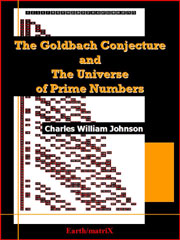
A SUMMARY OF AN EXTENSIVE ESSAY ON THE THEME OF:
The Beal Conjecture: Ax + By = Cz
A Proof and Counterexamples [Ax + By = zC]
Charles William Johnson
The conjecture Ax + By = Cz made by Mr. Andrew Beal is concerned with the common prime factor for positive integers and their exponents.
"If ,ax + by = cz , where A,B,C, x, y and z, are positive integers x, y and z are all greater than 2, then A, B and C must have a common prime factor." [Mauldin, 1997] This represents the original wording of the Beal Conjecture.
The Beal Conjecture requires positive integers in the terms [A, B, C] and exponents [x, y, z] of the equation (the latter whose value must be greater than 2). The products of the terms must reflect the selfsame multiplication of the terms in whole numbers or positive integers. Obviously, no fractional expressions are to appear in any of the three terms or three exponents of the equation. And, the most significant part of the conjecture affirms the necessity that the terms share a common prime divisor. Or, to the contrary, present counterexamples.
Terms with a common prime divisor produce whole number terms with whole number multiples (exponents). Terms without a common prime divisor produce whole number terms and whole number multiples but fractional proportions among the multiples. Terms without a common prime divisor with whole number terms and whole number exponents with whole number proportions among the multiples do not exist.........
If the difference between selfsame addition and selfsame multiplication were commonly perceived, then one would not propose the idea of counterexamples through selfsame multiplication, knowing the infinite number of counterexamples in selfsame addition. Furthermore, today's algebraic notation concentrates upon selfsame multiples through multiplication, which is an extremely limited number of possible relations of equivalency, a fraction of the possibilities attainable through selfsame addition. For a more exhaustive treatment of any mathematical subject, we should be teaching our students selfsame addition, which embraces the total universe of possibilities in these analyses.
Jefferson, Louisiana
22 August 2002
THE GOLDBACH CONJECTURE AND THE UNIVERSE OF PRIMES |
|||
Book: THE GOLDBACH CONJECTURE AND THE UNIVERSE OF PRIMES The Goldbach Conjecture and the Universe of Primes examines the even-sum
tables of the natural numbers and prime numbers in proving the conjecture.
The explanation of the inner workings of the Goldbach conjecture are rendered
into simple math. Knowing how to add is all that is required. Profusely
illustrated with easy-to-read math tables explaining how the sum of primes
perform in relation to the conjecture.
|
|||
Earth/matriX Editions
Earth/matriX:
Science in Ancient Artwork and Science Today
A SUMMARY OF THE ESSAY: ISBN
58616-327-2
August 2002
©2002-2015
Copyrighted by Charles William Johnson. ISSN-1526-3312
www.earthmatrix.com
Contact us for more information.
Charles William Johnson:mailto:johnson@earthmatrix.com
|
The Beal Conjecture:
A Proof and Counterexamples
( View full version in pdf file, 194 kb) |
| Home | Books | Author | Site map |

